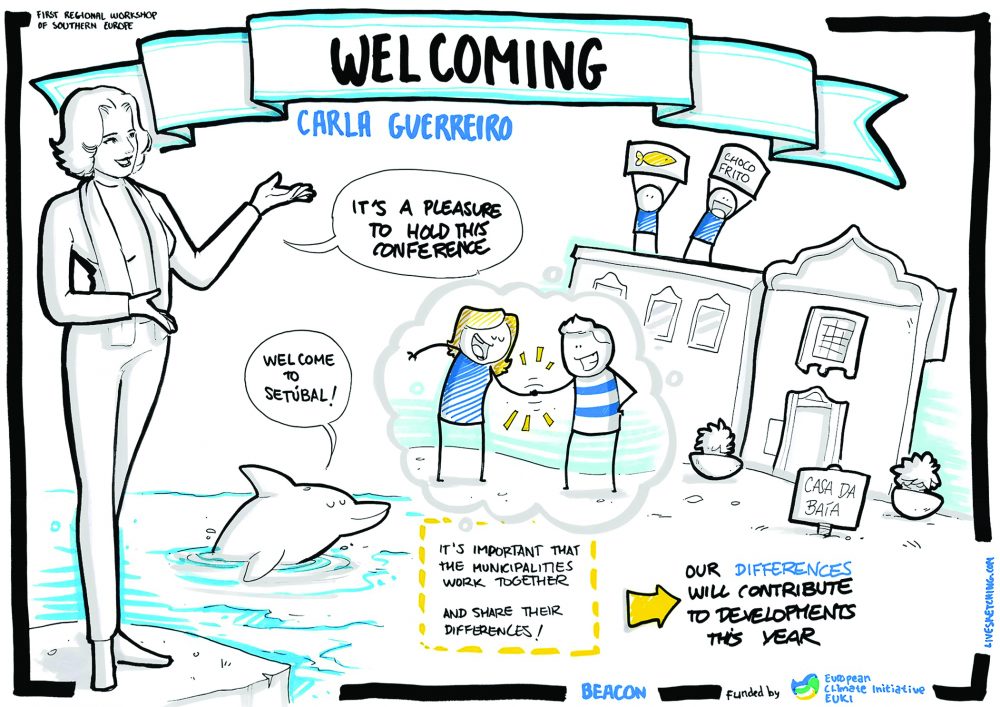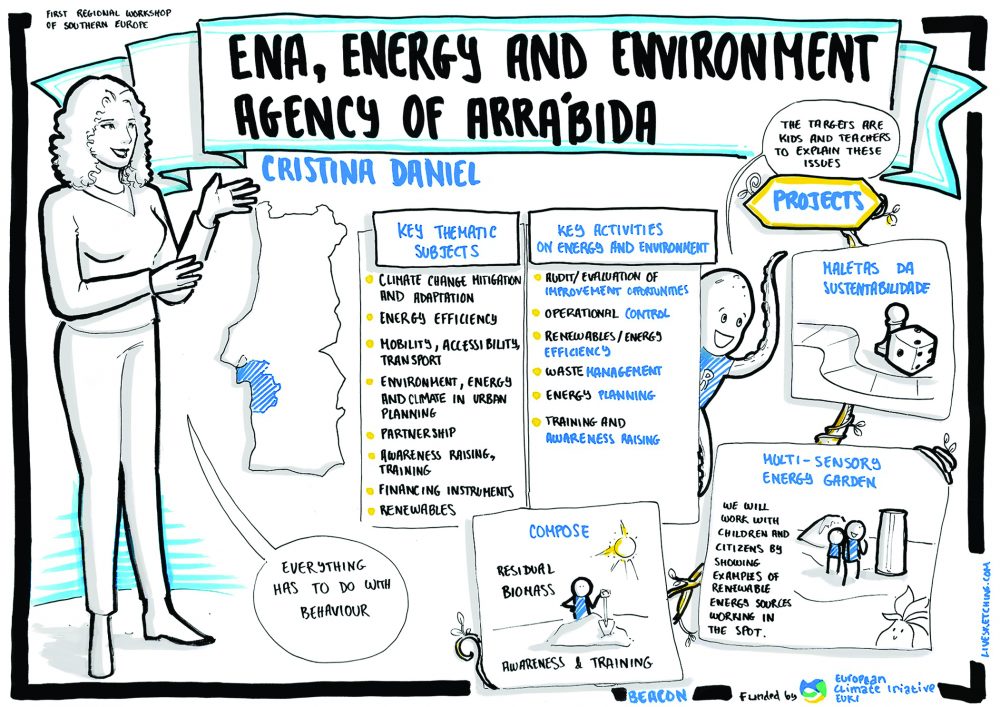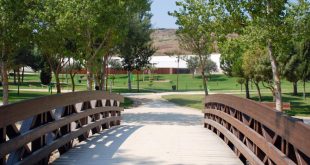As the host of the first BEACON regional workshop, Setúbal Council recently signed the mayors’ agreement, committing the municipality to reducing CO2 emissions by at least 40% by 2030. Climate change is now more than just a threat: the city has just finished the unprecedented task of dealing with the floods. With plans to expand the port in Setúbal and with some of the most polluting industries in the country, it will not be easy for the municipality to achieve the goal by switching from conventional lighting to LEDs. Setúbal’s strategy for climate and energy is on the table – and will be made available for public consultation with the participation of local people. ECO123 sat down with Carla Guerreiro, the Councillor responsible for the Environment and Energy.
How does Setúbal’s municipal council regard the problem of climate change?
As a priority. Especially in relation to the river Sado and flood prevention in our municipal area. We have been concerned about it for a long time. People are beginning to feel really troubled about it now, and most municipalities already regard combating climate change in relation to the environment as a priority.
What are the risks to the city as the climate situation gets worse?
We already have serious problems with the floods. These tremendous downpours, coinciding with the high tide, can cause flooding in the lower part of the city. At the present moment, it’s not a problem, but the concern is growing, as changeable weather occurs more often – as you can see today! [Outside, strong winds and rain are lashing the city]. We have had several years when we could literally only get through the lower town by boat. With this in mind, we applied for funds to build two retention basins, so as to have a place where water can be deposited upstream of the problem. This project is almost complete, involving an investment of 3.2 million euros. And this is our big mitigation measure in relation to climate change.
And what about prevention, namely reducing emissions? What is being done?
We’ve made a big change to our mobility plan and we’ve managed to reduce emissions, as far as the municipality is concerned. It’s a job that has to be done with the community, industry and the general population, because the part the council plays is very small.
What was this change?
Several alterations to the road system. We got rid of traffic lights. In many places where we used to have traffic lights, we’ve put in roundabouts. We’ve narrowed roads so that vehicles won’t travel at such fast speeds. We’ve put in cycle lanes. We’ve altered the existing mobility modes in order to improve mobility. Our territory has special advantages: our city is flat and it’s possible to get around on foot or by bicycle.
We’ve also tried to improve energy efficiency: we’ve already changed perhaps 25% of the street lamps to LED, as well as changing the traffic lights. We’re already planning new projects with LED. Some already have a remote control system.
We also pay attention to improving energy and water efficiency in municipal buildings, whenever any opportunities arise for refurbishment.
What are the goals of the municipality?
We’re supporting the mayors’ agreement. It’s a big commitment, which we agreed to last year: a reduction of 40% in emissions by 2030. It can’t just be the municipality through the measures it takes, it has to be the municipality together with stakeholders from the community. For a 40% reduction in emissions in a municipality, there have to be a lot of people pulling together in the same direction.

Doesn’t the current dredging project on the Sado and increasing the size of the Port of Setúbal endanger this objective?
It may even be the other way round. Today our port is only capable of receiving a certain type of ship. Very often, these are older ones, which cause more pollution. Because these ships have a very small capacity, we have to receive a lot of vessels in order to obtain a certain amount of cargo. The more modern ships can’t get in. Whilst remaining very wary about the environmental impact study, we think that the modernisation of the port is fundamental. It’s not a unique case, as our port has already been dredged several times…
… but not on this scale.
That’s true. But there are also two phases, it’s not all being done in just one go. And we’ve made a technical commitment to carry out very close monitoring and follow-up activities.
The population of Setúbal has been alarmed about the dangers of contaminating the river and the risks to the ecosystem, especially for dolphins.
A public meeting was held by the owner for clarification purposes. The municipality isn’t responsible for this area. It belongs to the Port of Setúbal. This question of sediment and possible contamination was brought up. What we were told was that tests had been carried out and that there was no danger, and it was planned that monitoring would take place while the sediments were being removed. We have the same concerns as all the other people have. But we also have to realise that our city has always had a port: it’s always grown and developed around the port and it’s fundamental for the port to be modernised. It’s a major project and means improving all types of access, including the railway.
But when we speak of modernisation, this usually corresponds to an increase in activity and necessarily an increase in emissions and pollution, both of the atmosphere and of the water. Is this guarded against in these plans?
What the studies made available to us point towards is an increase in the ability of ships to enter the port. Larger ships. But also equipment that is less polluting. As you know, this is the port where the products of AutoEuropa, among others, leave from. There is already a very significant amount of movement.
When we talk about climate change and the Setúbal region, we must also talk about industries. The Navigator factory was considered to be the second most polluting factory for the air in the whole of Portugal and the most polluting for the water. Are you concerned about the pollution associated with this industry, which is also linked to eucalyptus monocultures?
Navigator is a company that has already been in the municipality for a long time. It is responsible for a number of jobs and for the development of our region. Recently, an environmental committee was created, which includes the council and other bodies such as Zero, Quercus, parish councils and local authorities. All of these concerns were raised at that first committee meeting. Not in the sense of pointing the finger of blame, but of wanting to know more about the company’s indicators. Questions were raised about air quality and water use, because making paper requires a lot of water. A new meeting has been scheduled for May, so that Navigator can make all these data available. What they tell us is that they are a certified company and that, compared with a few years ago, all the indicators are much better. The truth is that people have many fears. Those who live in Setúbal have a characteristic saying that when the winds are in the right direction, “it smells like Socel” – the first pulp factory. People are used to living with it, but they are becoming more and more aware. And we have an obligation to obtain these data.

But, in the meantime, the council has also taken on this commitment to reduce emissions…
And all this work will also serve that purpose. We have other industries: SECIL, SAPEC and Lisnave… A lot of their activity is extractive in nature, and the big challenge we face today is how it is possible for companies to continue working whilst taking environmental challenges into account. It’s our obligation to make these processes transparent. It has been an interesting beginning.
What are the main obstacles to achieving this goal?
One of the main ones has to do with the system we live in. We speak and try to instil personal responsibility and it’s important, but, in this capitalist system, where the primary goal is making a profit, it’s difficult to incorporate all these concerns. We’re telling people, “you have to change your behaviour.” But we realise that it’s a drop in the ocean because there are large producers of carbon dioxide, industries that aren’t regulated, etc.
The most important thing is to educate people and make them aware. We have a software application that allows us to engage in a series of actions in schools and to target groups for the dissemination of the risks of climate change. We are also part of the Lisbon metropolitan area, where a major study of climate change is already in progress.
The new Lisbon airport is planned to be implemented in the district of Setúbal. The plan of the government and the multinational Vinci is to almost double the air traffic per hour…! Does this project worry you? Is it compatible with the commitments to reducing emissions?
We think that an investment is being made that may not solve the problem in the future. We’re talking about building an extension, not a new airport. And this will be mainly designed to receive smaller, cheaper flights, which may be even more polluting. It won’t solve the problem, because it’s going to be built and it’s already being said that it will have exhausted its capacity by 2050…
But this is from the perspective that it’s inevitable to continue increasing air traffic…
This is what has been pointed out… By not wanting to make a new airport, by keeping Portela and building a second one in Montijo, maybe we’re creating a situation where there may have to be even more traffic. Maybe if there were only one airport, it could be different. We have an airport in the middle of the city of Lisbon. Of course, this also causes problems. And now, in Montijo, the environmental impact study still has to be published. We don’t think this will solve anything. And we believe the investment that should be made isn’t going to happen. Ten years from now, we’ll be saying “and now where are we going to put a new airport”?
But will a new airport with a greater capacity from the start solve the problem when we’re here at a workshop looking for solutions to climate change?
It’s inevitable that people will move around more and more. It’s inevitable that, with all this movement of people and goods, we will have an airport with a suitable capacity for our requirements. Portela airport no longer has this. But if you ask me: can a person going from Lisbon to Porto, or from Lisbon to Faro, justify travelling by plane? If they can’t, they should go by train because it’s much cleaner. We have to think about these issues.
Are there reasons for optimism? Are there any examples of inspiring ecological projects in the municipality?
There are. There is reason to think that, although it’s difficult, it’s still possible to turn a lot of things around. I’ll give you an example, in our municipality, related to the oyster-fishing community. In Setúbal, many people used to make a living from oyster farming. After the 1970s, with the arrival of heavy industry, the oysters simply disappeared or became contaminated. At present, in 2019, we have several oyster producers, and we are even exporting them. A study was carried out by the ICNB [Institute for the Conservation of Nature and Biodiversity] and it gave us some very interesting results. We have oysters that are healthy and reproducing both in captivity and in the wild. Let’s say that the Sado River is certainly much better and less polluted. And, in the 1990s, no one would have said that this might be possible. This should make us face things in a more responsible way. It was possible to look at this problem, take action and turn back. There is still a time when it’s possible to turn things around. Now there must come a time when this won’t be possible. If we continue to
do exactly what we have been doing, or worse, it will be absolutely impossible to reverse this situation.
Then there are our dolphins: we have a community of dolphins, which is stable at present, living in this river. This allows us to face the future with hope.
These are important signs…
There are many council projects that I think are signs of optimism. Schools, organisations and cooperatives have taken the lead. It doesn’t have to be the municipality that does this; it has to be the people, and the municipality also supports these ideas.
Do you have an example?
Ocean Alive, a cooperative working in the Sado estuary, has conducted a very broad campaign, especially amongst the fishing community, calling for the removal of plastics from the river. Volunteers have done a lot and tons of plastic have been collected. The main mobiliser, Raquel Gaspar, has a huge love for the estuary, and she created the cooperative with the aim of helping the fishing community, especially fisherwomen and mollusc gatherers. Then there are our schools and our students, who are already in tune with environmental issues. We may think that these questions are only asked by a few people, but they are already very much instilled in our children. I went to the school the other day and one of the main concerns of those Year 9 children was dredging. It means they are aware of the city’s problems and environmental issues. It’s a very good sign!
Thank you.
 Eco123 Revista da Economia e Ecologia
Eco123 Revista da Economia e Ecologia

